If you’ve been in the aquarium hobby for a while, you’ll know that all aquarium plants need a source of light to grow and thrive. Not all plants are equal in their lighting needs, though: some need more than others while some not so much.
Looking to set up a low tech aquarium with beautiful plants where you don’t have to purchase and install an expensive lighting system?
Keep reading to find out more about running low light aquarium systems, as well as 9 different plant species that grow and thrive best in low light conditions.
How much light do low light aquarium plants need?
Many aquarium keepers think that strong lighting is the secret to having plants grow and thrive in their fish tank. While the quality of your light definitely plays a role in the success of your aquarium, the balance between CO2 levels, available nutrients, water quality, fish compatibility, and smart planting can make the difference between having a healthy and thriving plant and a plant that die after a few days.
That being said, how low light is low light? One thing is for sure: plants need light to perform photosynthesis and without the ability to perform this process, the plant dies. While some aquarium keepers have had success with keeping plants under the stock fluorescents that usually come with a new fish tank, these lights are often too low light and do not provide the plant with what it needs; these lights are usually only meant for viewing the fish and decoration in the tank and not supporting photosynthetic life.
What light is best for you?
Most popular now are LED light options as opposed to the T5 and metal halide options a few years ago. When it comes to narrowing down an exact light that will fit your aquarium best, there are thousands of lights to choose from; some enthusiasts even set up their own lighting rigs and systems using lights and materials from hardware stores. In general, a good light would have bulbs in the range of 5000k-10000k with a focused spectrum of red and green wavelengths.
For the most part, your fish won’t care about what light you choose. However, ultra-bright lights may cause your fish and invertebrates to be shyer and may not replicate the natural darker and blackwaters some species originate from.
Can aquarium plants survive under natural sunlight?
Theoretically, yes; plants survive just fine in the wild with natural sunlight, even after a couple of consecutive cloudy or rainy days. The problem with using natural sunlight to feed aquarium plants is that it is a much smaller system, and any fluctuations are less easy to be corrected by themselves. There are two main problems you can run into with using natural sunlight to grow your plants: either too much light or not enough light.
If your aquarium is receiving too much light, you will have to potentially deal with frequent algae blooms. Because you can’t shut off or monitor the intensity or period of your light, algae will more than likely thrive. This could lead to a whole assortment of problems for your aquarium plants, such as the algae choking them out for nutrients and light, or just causing an unsightly mess that also gets caught up in your equipment and causes your fish problems.
If you are fortunate enough to not experience an algae bloom or have managed to manually control it, you still have to worry about your plant receiving too much light. Most freshwater aquarium plants don’t actually need too much light, so giving more than they need can lead to your plant melting. Even more so, all this added natural light will cause the temperature in your aquarium to rise, so a chiller could be necessary to help monitor safe temperature conditions for your fish. Otherwise, both your plants and fish could be at risk of overheating.
The other problem you may experience is your aquarium getting too little light, especially if you are in a region of the world that experiences four seasons. It is important to know if the plants in your aquarium are able to live and grow even if it is overcast for a few days or when the days are shorter during the winter and longer during the summer; you also need to know if your plants are able to make that transition between the seasons as light intensity and period increases and decreases from day to day during the spring and fall.
However, some people do manage to keep successful natural fish tanks that grow beautiful plants that thrive. There are ways to manipulate the conditions you want, even if they’re from a natural source. The best way to approach running an aquarium that solely depends on natural sunlight is to look at the aquatic plants that naturally grow in your location; these plants are proven to survive the light intensities and periods as well as the changing seasons.
If you want to look even further beyond the plants in your region, you will have to go through a lot of trial and error. Some supposed low light aquarium plants may grow even better under high lighting and vice versa. If you’re willing to take the time to understand what your fish tank can grow, it will surely be more than worthwhile!
What are good low light aquarium plants?
Here we will list 9 plant species that could be perfect for your low light aquarium, such as Java fern, Amazon sword, dwarf Sagittaria, and several others:
Anubias (Anubias barteri, Anubias nana, etc.)
No list of low light aquarium plants is complete without mentioning the almighty Anubias. This plant is a staple in many low tech aquariums because it thrives with minimal attention and is tolerant of a wide range of conditions and environments.
Naturally found in West Africa, Anubias plant typically has broad, rounded leaves. The plant does best when attached to driftwood or rocks, as it has yet to evolve to grow well in the substrate. It’s not fond of being under harsh light, so if the rest of the plants in the aquarium can handle it, you should create lots of shade by adding floating plants to the surface of the tank.
Because of its sturdy leaves, Anubias is a favorite for many labyrinth fish looking to take a nap near the water surface! Bettas, in particular, enjoy resting amongst the leaves, and other fish and invertebrate species will greatly appreciate the added cover.
You can find a full-plant care sheet for Anubias on Aquariadise here.
Java fern (Microsorum pteropus)
Java fern is another common sight on lists for low light aquarium plants that is beloved by both beginners and expert plant keepers alike. Like Anubias, Java fern does best when attached to driftwood and rocks. All you need is a little bit of super glue or fishing line and wait for it to secure itself, and you’re good to go.
Java fern has long, sharp leaves that easily fill spaces, especially in new tanks. Underneath the leaves, you’ll find rows of round, brownish-black spores that can make beginners mistakenly think they’re dealing with algae. In reality, these spores–a characteristic of all ferns–can produce plantlets that you can replant for a fuller and greener look in the aquarium.
Unfortunately, just like with the slow-growing Anubias, you may have to deal with algae on Java fern more than you’d like if the water conditions aren’t ideal.
You can find a full Java fern plant care sheet on Aquariadise here.
Java moss (Taxiphyllum barbieri)
Java moss is a hardy aquatic moss that can be attached to wood and rocks both below and above water to give any aquarium setup a more natural look. That’s why Java moss is not only a popular aquarium plant but also commonly used in paludariums and terrariums as well. The trick to having Java moss grow its best in its emergent form is to have a tight-fitting lid to help keep the moisture in, which will create a humid environment.
Java moss is also hugely beneficial for shrimp and fish fry that need extra hiding places in a community or breeding tank. Its fine-leaved, stringy fronds contain a wealth of edible biofilm and offer plenty of covers.
The only drawback for Java moss is that it’s a massive trap for debris, so extra care should be taken when cleaning. If fronds begin to brown or die off, you might need to trim the plant to keep it healthy.
If you’re a fan of Java moss, you can find a list of more aquatic moss species over on Houseplant Central here.
Crypts (Cryptocoryne wendtii)
Crypts, such as Cryptocoryne wendtii, are great plants for filling out the floor of an aquarium. There are many varieties out there that vary in size, with some being suitable for nano aquariums and some for very large aquariums. Additionally, a range of selectively cultivated colors is now available, like the spectacular pink Cryptocoryne “Flamingo”!
Do keep in mind that crypts can be a bit finicky during the acclimation process. Many plants suffer some discoloration and have leaves die off as they acclimate to a new aquarium, but it’s much quicker and more obvious with crypts. It’s not uncommon to see leaves dying in as little as a day or two after planting (also known as the dreaded “crypt melt”). However, resist the temptation to pull out the whole plant. Once it settles, it should start to grow in little to no time.
If you have a small aquarium, Cryptocoryne wendtii is a safe species of this plant to grow since it doesn’t tend to get more than 6 inches tall and 6 inches across. Like many other crypts, Cryptocoryne wendtii is available in a variety of colors, including green, brown, and red. As such, it can easily fit in with any aesthetic.
You can find a full Cryptocoryne plant care sheet on Aquariadise here.
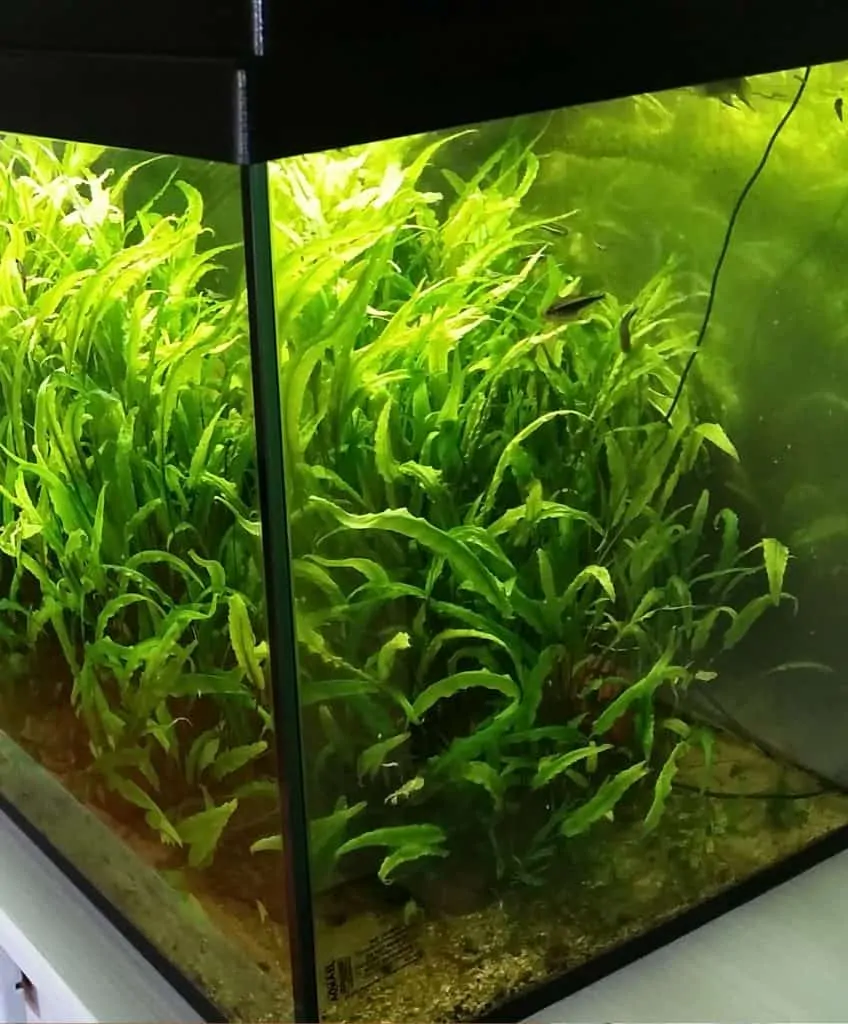
Amazon sword (Echinodorus sp.)
If you want a big plant to fill in your tank right from the start, especially in the background, the Amazon sword is a solid bet. Amazon swords grow big and tall (over 20 inches/50 cm), with leaves that come in a number of shapes and sizes, such as the popular Echinodorus amazonicus and Echinodorus bleheri.
Amazon swords are known for needing a lot of nutrients in the substrate to grow and thrive. This might intimidate beginning planted aquarium enthusiasts, but it’s actually quite easy to provide the plant with what it needs by simply placing a few root tabs in the substrate. Given their sheer size, Amazon swords don’t tend to do their best in nano aquarium setups.
Although Amazon swords are great for low light aquariums, they will do their best with 10-12 hours of medium to high light. Given their love of light and how slowly they grow in low light setups, algae growth can be an issue if left unchecked.
You can find a full Amazon sword plant care sheet on Aquariadise here.
Marimo ball (Aegagropila linnaei)
Although a lot of hobbyists complain about algae, there is one type of algae that many happily welcome into their home aquarium: Marimo moss balls!
Marimo balls are often referred to as moss balls but actually consist of a type of algae called Aegagropila linnaei that naturally tends to grow in round shapes under the right conditions. These “moss balls” are commonly found in unheated shrimp setups because of their extreme ease of care and preference for lower temperatures. Very little is needed for Marimo balls to thrive, although you should rotate them now and again for aeration and help maintain their round shape.
Fun fact: Marimo Matsuri is a yearly festival in Hokkaido, Japan held by the indigenous Ainu people. The festival is aimed at raising awareness for Marimo ball conservation. In recent times, large patches of Marimo balls have disappeared from Lake Akan, raising concerns.
You can find a full Marimo ball care sheet on Aquariadise here.
Water wisteria (Hygrophila difformis)
If you want a tall, feathery plant, then water wisteria is an excellent choice. Scientifically known as Hygrophila difformis, this a stem plant that provides excellent cover for shy fish and shrimp. Do remember that this plant grows rather fast: regular pruning of its leaves will be needed to keep it from becoming too unruly. If left to do its own thing, this species may actually outcompete nearby plants in the aquarium.
Although it’s commonly listed amongst low light aquarium plants, Hygrophila difformis tends to do best in medium to high light. Whether it’s suitable for your low light tank depends entirely on your preferences: its growth pattern differs according to lighting conditions. If you want fine, feathery leaves, keep Hygrophila difformis under high light. If you want the more untamed look, keep it under low light. Because these leaves can come in two variations, Hygrophila difformis is often mislabeled in aquarium stores.
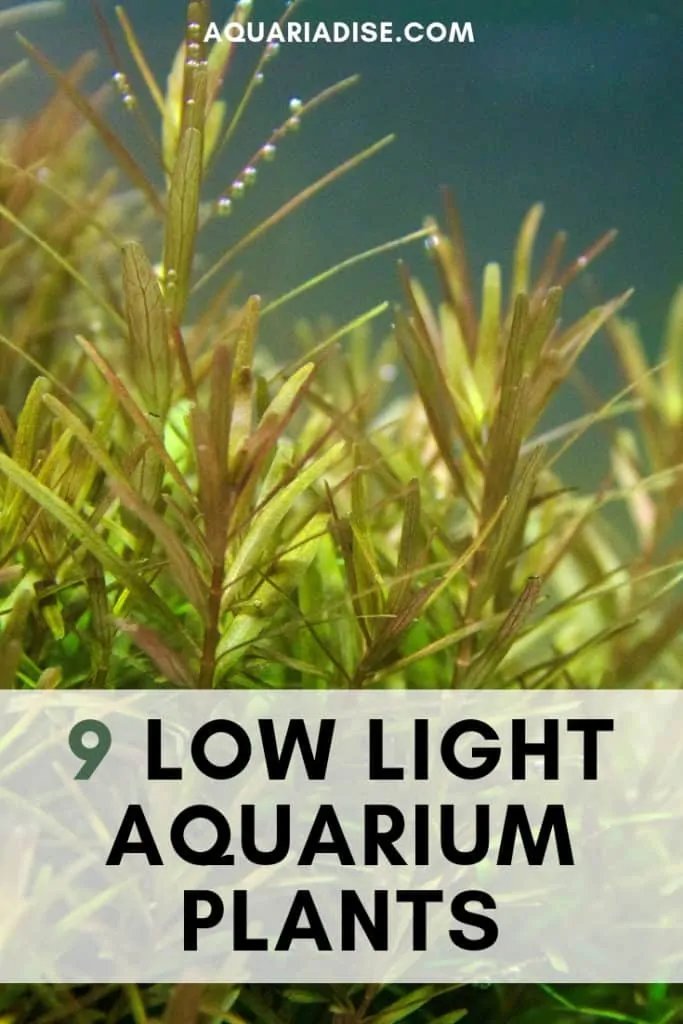
Dwarf Rotala (Rotala rotundifolia)
If you’re a little tired of seeing nothing but green leaves in your aquascape, Rotala rotundifolia is well worth checking out because of its red coloration. Unlike other members of the Rotala family, Rotala rotundifolia can be lumped in with low light aquarium plants and still do well. However, it should be noted that Rotala rotundifolia is often reddest under medium to high light.
Rotala rotundifolia is a stem plant with many fine leaves that give it a lush, compact look. If Rotala rotundifolia is grown emersed, its leaves will be a brighter green and rounded, while submersed plants tend to have narrower and sharper reddish leaves. However, since it may grow shoots out from its sides, regular pruning will need to be done to make sure the lower leaves get enough light. When left unchecked, the bottoms of the stems might shed their leaves, making for a bare look.
Dwarf Sagittaria (Sagittaria subulata)
A lot of people get discouraged because there doesn’t seem to be many carpet low light aquarium plants readily available. Fortunately, you don’t need to fret anymore: dwarf Sagittaria is here to save the day!
Sagittaria subulata is a grass-like foreground plant that grows fast and is ideal for covering the floor of a new aquarium. However, it’s been noted that sometimes Sagittaria subulata can grow too tall, reaching up to 12 inches. Yet, when it’s moved to the background, Sagittaria subulata has the tendency to grow low to the ground again.
To best avoid issues with the plant grows too tall, it’s helpful to regularly “mow the lawn” in order to keep your dwarf Sagittaria at the desired height. Simply snip leaves where desired using your aquarium pruning scissors!
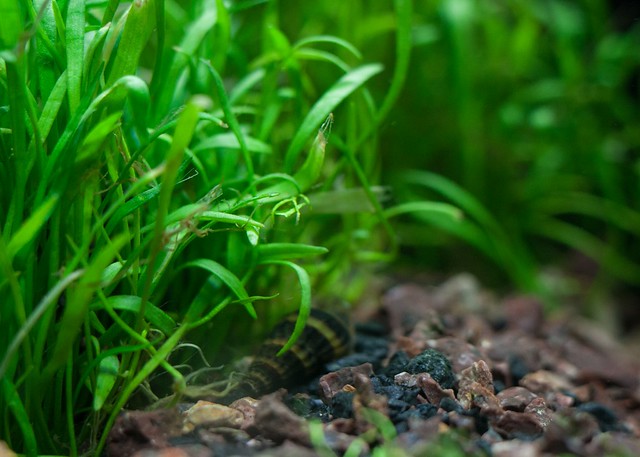
Buying low light aquarium plants
So you’ve decided on a plant species that you think will work best for your own low light aquarium. Now it’s time to actually go out to the store and get it. But what happens if the plant is under stronger or weaker lighting than you have on your tank?
The first few weeks of owning any new plant can be a little daunting; there are a lot of things that can go wrong and there is always a chance that the plant won’t survive. Honestly, differences in lighting are the least of your concerns. Some people quarantine their new plant for a few days, just to make sure there aren’t any live pests hitching a ride into their tank. The bare minimum you should do before introducing the plant into your tank is checking for any outstanding pests and pruning any yellowed or browned leaves.
Acclimation
You should make sure to put the new plant in a space that describes its preferred conditions since it is not recommended to move the plant afterward. If you are moving a plant from low light to high light, it may be best to place the plant in a shaded area or lower your lighting settings if you have the ability; make sure that your other plants can withstand the change in lighting before you do this, though. If you are moving a plant from high lighting to low lighting, it may be best to place the plant directly under the lights.
In either situation, the plant will have to acclimate itself to your tank conditions. Even if the change isn’t drastic, the plant will probably start to turn a little yellow or lose some leaves. This may be due to lighting, but it could also be due to other unfavorable parameters, such as ammonia or CO2 levels.
Always make sure that the plant you are buying doesn’t have rotting leaves; the leaves should be full and vibrant in color. Also, make sure that whatever plant you decide on getting is compatible with the fish or invertebrates you plan on getting or already have.
Conclusion
You don’t need fancy equipment to set up a beautiful low light planted tank. In these delicate systems, it’s even more important that you maintain water quality and make sure the plants are getting the nutrients they need to grow and thrive at their best.
While some of the plants listed prefer medium to high light, there are definitely success stories out there about plant keepers being able to grow the same species under low light; there is a lot of trial and error in this hobby. Even if you get a low light plant, there is still a chance that it won’t like your light and won’t do its best. The same could be said for someone who has the best equipment: there will always be at least one plant that simply refuses to grow in your tank.
If you have any more questions about these easy low light aquarium plants or if you want to share your own experiences with a low light plant species mentioned here, don’t hesitate to leave a comment below!

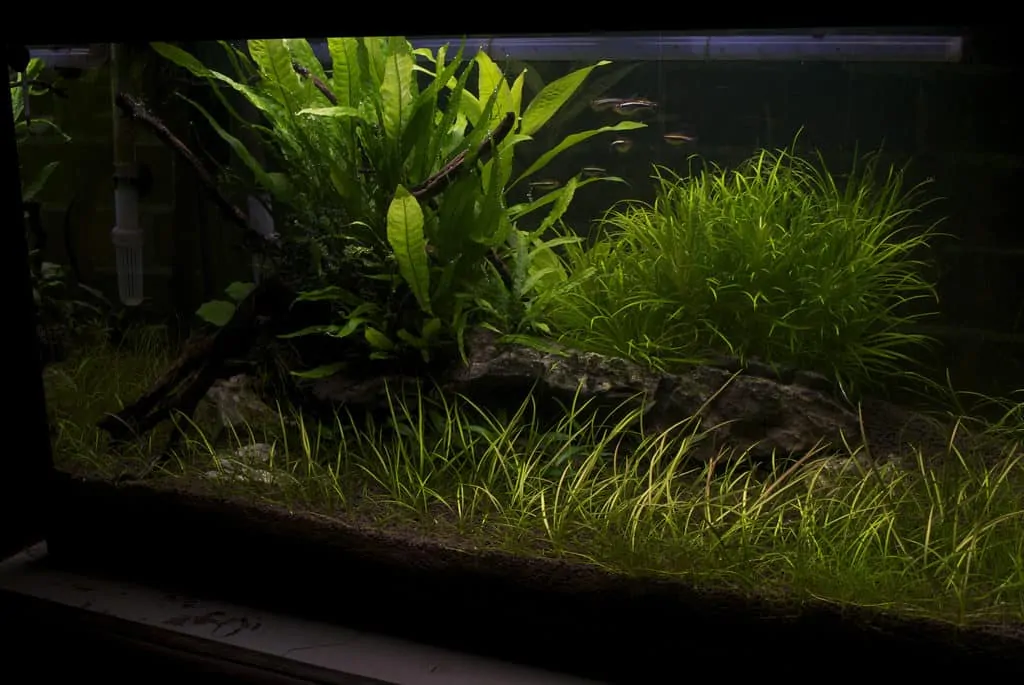






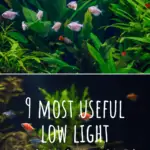
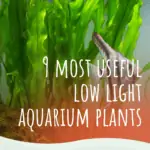
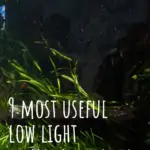
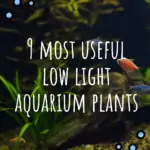

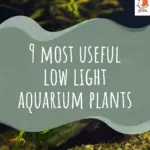
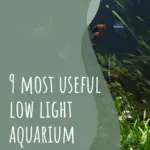
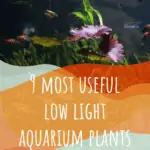
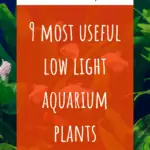
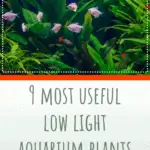
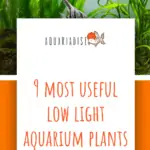

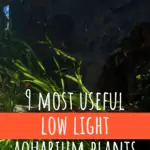
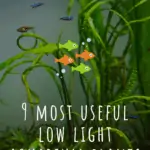
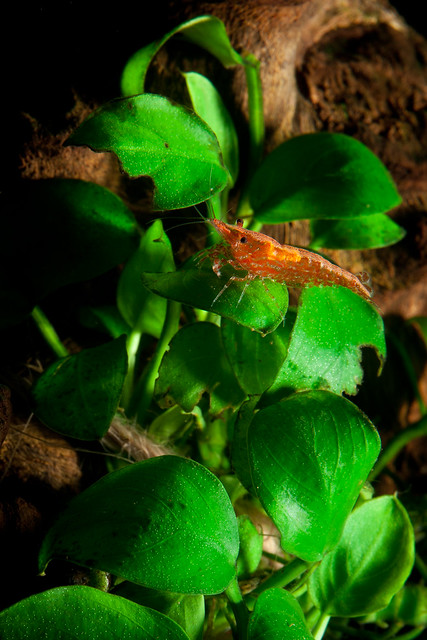
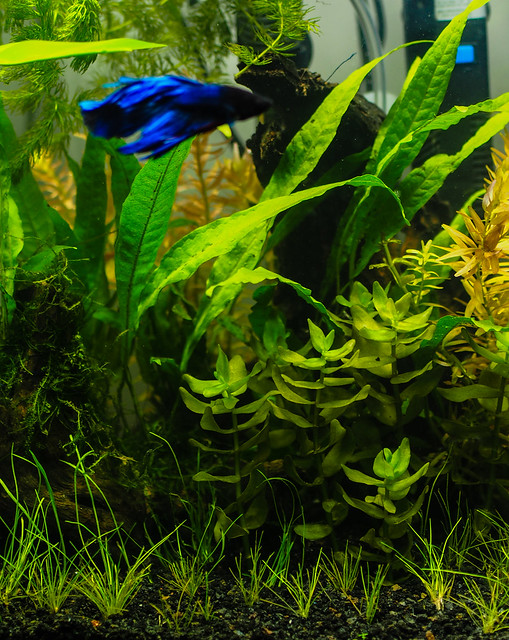
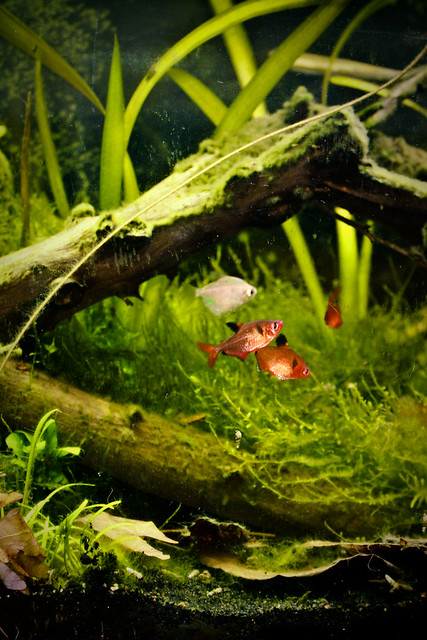
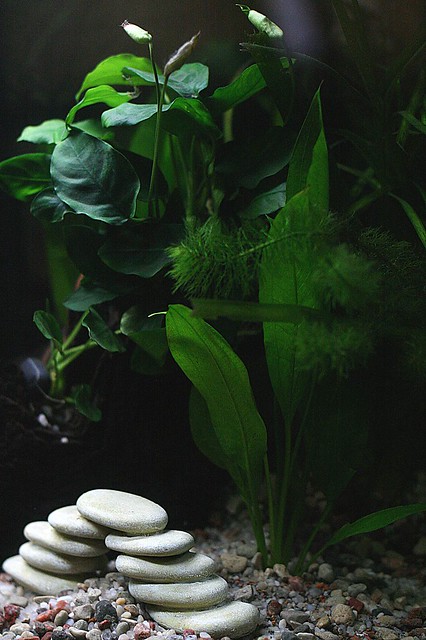
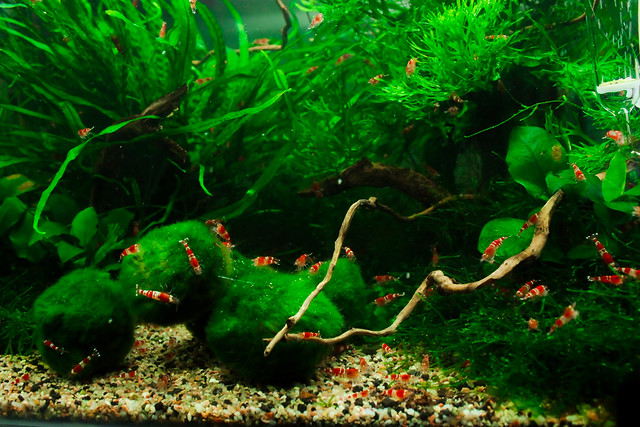


Thank you for this informative blog! I can attest to what you said that light is necessary for the aquarium for the plants’ survival based on my experience where I didn’t know that it was a must. I would like to ask if it’s really needed to have plants in the aquarium or if the fish can survive without them?
Live plants are not necessary! They can certainly make aquarium keeping much easier though.
Thank you, one last question: what kind of food would I give the plants? Sorry if this sounds dumb. If the food isn’t a common household item, where can I buy some?
Your plants should be well enough with the fish food and fish waste you’re putting into the system. If you have a particularly heavily planted tank, then you might need fertilizers. If you do decide to dose fertilizers, then you will need to track how nutrients are being imported and exported from your system (sounds harder than it is). Once the nutrients start rising due to the fertilizer, it’s time to do a water change.
You can use root tabs or liquid fertilizers. I like NilocG.
Thanks for the article, Mari. I believe I’ve read somewhere that you should quarantine your plants before putting them in your aquarium. Is this true? I plan on settling in the plants before/during cycling (before buying a betta). I have some Java fern, Java moss, and Amazon frogbit. If I’m supposed to quarantine them, how would I go about doing that? I only have one tank, so would a large container/bowl work (with the right conditions, of course)?
In theory, it’s always recommended to quarantine anything you plan on putting into your tank. Quarantining your plants is mainly to prevent snails and other pests from entering the system.
Instead of a full quarantine tank setup that will take away from cycling time, I would recommend setting up the tank and treating your plants with a dip beforehand, though quarantine if you can. Some hobbyists choose to do a bleach dip or peroxide dip mixed with ich medications.
If you do choose to quarantine, about 3-4 weeks should be long enough. A container with light regular water changes will be enough. Simply give a little food every few days.